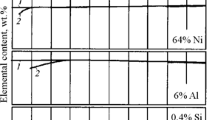This articles discusses the use of 20Kh23N18T mark stainless steel and its foreign analogue AISI 310S instead of 12Kh18N10T steel as a material for making shaping dies used in the manufacture of glass insulators made from S93-3M mark electrovacuum glass. Such insulators are widely used in the radio-electronic industry as housings for magnetically operated contacts. It is shown that at operating temperatures a chemical interaction occurs between both grades of steel and S93-3M grade glass, which results in deterioration in the product quality on account of the appearance of a large number of gas bubbles in the product. It was ascertained that the additional heat treatment makes it possible to diminish the consequences of this chemical interaction, and thereby improve the quality of the resulting product.



Similar content being viewed by others
References
L. I. Rabkin and I. N. Evgenova, Magnetically Controlled Sealed Contacts (Designs, Properties, Application) [in Russian], Svyaz’, Moscow (1976).
S. M. Karabanov, Yu. G. Ivanov, R. M. Maizels, et al., “Pat. 2307418 RF, IPC N 01 N 36/00. Precision limit reed switch, No. 2006107881/09,” Byull. Izobr. Polezn. Modeli, No. 27 (2007), patent holder JSC R.Z.M.K.P., dec. 03/13/2006, publ. 27.09.2007.
S. D. Gostev, “Investigation of the reason why bubbles appear in production of tubes from S52-1 electrovacuum glass by drawing a glass block from the melt through a die in shaft-type furnaces,” in: A. A. Fomina (ed.), Modern Materials and Technologies: Materials of the 2nd Intern. Youth Conf.: Collection of Scientific Articles, Saratov, May 19 – 20, 2021 [in Russian], SGTU, Saratov (2021), pp. 54 – 56.
I. I. Kitaygorodskii (ed.), Glass Technology [in Russian], Stroiizdat, Moscow (1967).
A. P. Sivko, Technology of Electriclamp Glass, Textbook [in Russian], Izd. Mordovsk. Univeriteta, Saransk (2015).
E. Z. Silaev, V. P. Lysenkov, I. Ya. Yanikin, et al., “A.S. 753794 USSR, M. Kl3 C 03 B 17/04. Set-up for the production of glass tubes and rods,” Byull. Izobr. Polezn. Modeli, No. 29 (1980), dec. 07/05/78, publ. 07.08.80.
A. V. Shcherbakov and I. A. Shcherbakov, “Pat. 2618245 RF, IPCC 03B 37/08. A spinneret for the manufacture of glass rods (variants), No. 2016103495,” Byull. Izobr. Polezn. Modeli, No. 13 (2017), patent holder OOO T.O.S.S., dec. 02/03/2016; publ. 05/03/2017.
GOST 5632–2014. Stainless Steels and Alloys are Corrosion-Resistant, Heat-Resistant and High-Temperature. Marks. Instead of GOST 5632–72; Input 2015-01-01 [in Russian], Standartinform, Moscow (2015), 48 p. (National standard of the Russian Federation).
E. V. Poyarkova and A. V. Yakhin, “Influence of high-temperature heating on the structure of surface oxides of stainless steel,” Vest. Tambov. Univer., Ser. Estestv. Tekh. Nauki, 21(3), 1267 – 1270 (2016).
Yu. P. Perelygin, I. S. Los, and S. Yu. Kireev, Corrosion and Protection of Metals from Corrosion, Textbook [in Russian], Izd. PGU, Penza (2015).
A. M. Borzdyka and V. Z. Zeitlin, Heat Treatment of High-Temperature Steel and Alloys [in Russian], Mashinostroenie, Moscow (1964).
Kh. M. Ibragimov, V. I. Filatov, and V. L. Ilyichev, Fundamentals of Technological Processes of Heat Treatment of Steel: Textbook [in Russian], Izd. Tsentr YuurGU, Chelyabinsk (2009).
GOST 8233–56. Steel. Microstructure Standards; Intro. 1957-07-01 [in Russian], Izd. Standartov, Moscow (2004).
N. G. Kunitsina, Theory and Technology Pressure-Processing of Metals: Textbook [in Russian], NF NITU MISiS, Novotroitsk (2015).
V. A. Golenkova and S. P. Yakovleva (eds.), Theory of Pressure Forming of Metals: Textbook [in Russian], Mashinostroenie, Moscow (2009).
Author information
Authors and Affiliations
Corresponding author
Additional information
Translated from Steklo i Keramika, No. 7, pp. 3–8, July, 2023.
Rights and permissions
Springer Nature or its licensor (e.g. a society or other partner) holds exclusive rights to this article under a publishing agreement with the author(s) or other rightsholder(s); author self-archiving of the accepted manuscript version of this article is solely governed by the terms of such publishing agreement and applicable law.
About this article
Cite this article
Gostev, S.D., Gotz, I.Y. & Nasad, T.G. Chemical Interaction Between Heat-Resistant Steel and S93-3M Mark Electrovacuum Glass: An Investigation. Glass Ceram 80, 267–270 (2023). https://doi.org/10.1007/s10717-023-00596-4
Received:
Published:
Issue Date:
DOI: https://doi.org/10.1007/s10717-023-00596-4




